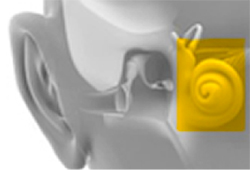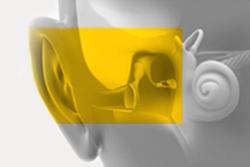Depending on which part of the ear is damaged, hearing loss can be classified by one of four types.
SENSORINEURAL

*Hybrid hearing approved only for use with the Hybrid L24 Implant.
CONDUCTIVE

MIXED

SINGLE-SIDED DEAFNESS

The Degrees of Hearing Loss

MILD
Able to hear the loud or more intense vowel sounds, but may miss some of the softer consonant sounds. People with a mild hearing loss may have difficulty hearing soft spoken people and young children. Also, they may have to ask people to speak up or repeat themselves on occasion. Hybrid hearing can help amplify low-pitch sounds as well as bring back high-pitch sounds that are missing.*
MODERATE
In addition to missing consonant sounds, vowel sounds then become more difficult to hear. People with a moderate hearing loss often comment that without hearing aids they hear, but can’t always understand. Hybrid hearing can help amplify low-pitch sounds as well as bring back high-pitch sounds that are missing.*
MODERATELY SEVERE
Without hearing aids, speech becomes inaudible. Even with hearing aids, speech may still be difficult to understand and increasing the volume doesn’t always make it clearer. That’s why a cochlear implant might be a better option for adults.
SEVERE
Without hearing aids, speech is inaudible, but loud sounds like a baby crying or a dog barking are audible. A cochlear implant is often the best option for adults and children.
PROFOUND
Without hearing aids, speech is inaudible, but very loud sounds like a lawn mower or jet airplane are audible. Again, a cochlear implant is often the best option for adults and children.
*Hybrid hearing approved only for use with the Hybrid L24 Implant.
For more information, view https://www.cochlear.com/wps/wcm/connect/us/home/about-us-and-hearing-loss/hearing-loss-explained
